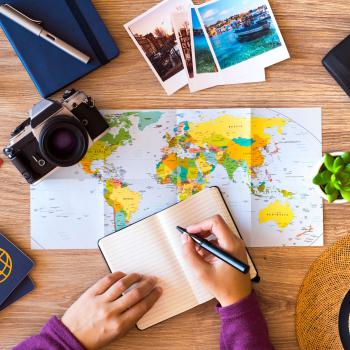Travel Brochures: Highlighting the Setting of a Story

- Preview |
- Standards |
- Resources & Preparation |
- Instructional Plan |
- Related Resources |
- Comments
Overview
Imagine the images and detailed descriptions of the places depicted in a book you've read recently—whether a far-away land, a historical location, or a city just like the one you live in. Settings transport readers to these places, inviting them to consider what it would be like to visit these locations personally. This lesson plan takes that imaginary tourism one step further by asking students to create a travel brochure for locations in texts that they have read. The activity requires students to think about and collect the details mentioned in the text that should be highlighted and conduct additional research on the location as they design their own brochures.
This lesson plan uses Al Capone Does My Shirts by Gennifer Choldenko as the example; however, any text in any genre would work well.
Featured Resources
Travel Brochure Rubric: Use this rubric to evaluate the organization, ideas, conventions, and graphics of travel brochures students have created.
Recording the Setting Bookmark: Students use this reproducible sheet, which can be cut into bookmarks, to record details about a story's setting as the read.
Printing Press: Use this online tool to create a newspaper, brochure, booklet, or flyer. Students choose a layout, add content, and then print out their work.
From Theory to Practice
Often, students end a unit of study by writing a traditional research paper. While this is a good way for students to summarize what they have learned, it may not be the most interesting. Beyond that, it frequently results in summary and rote repetition rather than deep critical thinking. In this lesson plan, students go through the research process, but will take that information and turn it into a travel brochure. In her English Journal article, Janet Northrup says, "Unlike a research paper that usually has two readers, the teacher and the student, a pamphlet encourages ownership of a topic, a topic which each student knows will be shared with (and taught to) others. Also, class members develop research skills. They learn how to find information, develop a sense of voice and audience, write an arguable thesis statement, select relevant facts, create an interesting layout, and edit carefully." This project will meet the needs of both students and the teacher.
Further Reading
Common Core Standards
This resource has been aligned to the Common Core State Standards for states in which they have been adopted. If a state does not appear in the drop-down, CCSS alignments are forthcoming.
State Standards
This lesson has been aligned to standards in the following states. If a state does not appear in the drop-down, standard alignments are not currently available for that state.
NCTE/IRA National Standards for the English Language Arts
- 3. Students apply a wide range of strategies to comprehend, interpret, evaluate, and appreciate texts. They draw on their prior experience, their interactions with other readers and writers, their knowledge of word meaning and of other texts, their word identification strategies, and their understanding of textual features (e.g., sound-letter correspondence, sentence structure, context, graphics).
- 4. Students adjust their use of spoken, written, and visual language (e.g., conventions, style, vocabulary) to communicate effectively with a variety of audiences and for different purposes.
- 5. Students employ a wide range of strategies as they write and use different writing process elements appropriately to communicate with different audiences for a variety of purposes.
- 6. Students apply knowledge of language structure, language conventions (e.g., spelling and punctuation), media techniques, figurative language, and genre to create, critique, and discuss print and nonprint texts.
- 7. Students conduct research on issues and interests by generating ideas and questions, and by posing problems. They gather, evaluate, and synthesize data from a variety of sources (e.g., print and nonprint texts, artifacts, people) to communicate their discoveries in ways that suit their purpose and audience.
- 8. Students use a variety of technological and information resources (e.g., libraries, databases, computer networks, video) to gather and synthesize information and to create and communicate knowledge.
- 11. Students participate as knowledgeable, reflective, creative, and critical members of a variety of literacy communities.
- 12. Students use spoken, written, and visual language to accomplish their own purposes (e.g., for learning, enjoyment, persuasion, and the exchange of information).
Materials and Technology
- An assortment of travel brochures
- Various reference materials, print and online
Printouts
Websites
Note that the National Geographic Website does have ads.
Preparation
- Collect travel brochures from travel agents, your local chamber of commerce or convention and visitors bureau, and other sources.
- Make appropriate copies of the handouts for students: Things to Include in a Travel Brochure handout, Example Research Notes, Travel Brochure Rubric, Recording the Setting Bookmark.
- Have a copy of the Example Bookmark, Example Research Notes, and Example Setting Brochure to share with the students.
- Test the Printing Press on your computers to familiarize yourself with the tools and ensure that you have the Flash plug-in installed. You can download the plug-in from the technical support page.
Student Objectives
Students will
- learn what makes a good travel brochure by examining commercial brochures.
- think critically about text details from a text they have read.
- create a travel brochure that incorporates research skills and text details.
Session One
- Ask students to share their experiences with traveling:
- Where did they go?
- How did their families decide to go to these places?
- What kinds of brochures, travel guides, books, and/or advertisements did their families explore before traveling?
- Where did they go?
- If students have experience with travel guides and travel brochures, invite them to share what they remember about them.
- Explain that the class is going to create travel brochure about one of the texts that students have read, focusing primarily on the setting of the story.
- Display a variety of travel brochures. Provide time for students to look through the brochures, in groups, pairs or individually. Ask them to pay attention to layout, the highlighted features, illustrations, and the style of the included text.
- After the students have had some time to look through the brochures, ask them to share more about what they saw in the brochures. The following questions can guide the discussion:
- Are there maps? photos? diagrams? other illustrations?
- What kind of language and vocabulary is used?
- How is text presented? paragraphs? bulleted lists?
- Are there specific places highlighted? What kind?
- Are there maps? photos? diagrams? other illustrations?
- Ask the students if they would like to visit any of the places in the brochures. If the students answer affirmatively, ask them to share what in the brochures made them want to visit. If students answer negatively, ask them to share why they would not like to visit that locale.
- Have students brainstorm what make an effective travel brochure. Record their responses on the board or on chart paper. Some answers may be the pictures, the supporting text, the quotes from visitors, and so forth.
- Explain that while the pictures and photos are added bonuses on travel brochures, the text plays an important role in persuading people to visit a certain place.
- Review persuasive writing with students: In a persuasive writing piece, students begin by determining their goal or thesis. They then identify three reasons to support their argument, and three facts or examples to validate each reason. The Persuasion Map Planning Sheet makes a good visual for the students.
- Brainstorm the kinds of information students need to include in their travel brochure. Record this information on the board. You can also refer to the Things to Include in a Travel Brochure handout.
- Show the students the Travel Brochure Rubric so they know the requirements for the project.
- Once students know the expectations for the assignment, ask them to choose a text for their brochures. Try not to have too many students using the same text. This lesson plan uses Al Capone Does My Shirts by Gennifer Choldenko as the example.
Session Two
- When all of the students have selected a text for the project, invite them to revisit the text to look for examples and passages about the setting.
- Demonstrate how to use the Recording the Setting Bookmark to note the examples from the text. Display the example bookmark and discuss the details that are included.
- Pass out copies of the Recording the Setting Bookmark for students to use.
- Give students the rest of the session to collect details from their books.
- As students examine their texts for examples, circulate through the room. This is a good time to take observational notes or ask students questions as they are working.
Session Three
- Once students have found examples from their text about the setting, explain that it’s time for them to conduct research on the setting using the Internet, reference materials, magazines, newspapers, etc. Students can visit Notes from the Road and Travel & Cultures for information on many areas of the world. If the students are using a Science Fiction or Fantasy text, they may have a more difficult time with the research. In that case, they should rely more on their findings in the text.
- Invite students to record their research findings on the Things to Include in a Travel Brochure handout. Share with them the example research notes.
- As students are researching, help as needed.
- Briefly demonstrate the Printing Press for students. Show the students how they can use the tool to create their finished product. Place students’ emphasis on thinking about the content for the brochures and flyers, as the Printing Press will make the process of making the final product a simpler one.
- You can also share with the students an example setting brochure of a book that the class has read so they can see what they can include in their own brochures.
Session Four
- After students have gathered clues from their texts as well as completed research on their setting, they are ready to begin working on creating their travel brochures, highlighting the setting of a text using the Printing Press.
- Assist students as needed.
- Remind students that they cannot save their work on the Printing Press so they will need to work diligently on their project.
Session Five
- Once all of the students have completed their brochures using the Printing Press, allow time for the students to share their brochures with the rest of the class.
- Assess the students work using the rubric.
Extensions
- Instead of making a travel brochure about their setting, students could design a postcard highlighting one of the locations mentioned in their text. Students can publish this postcard using the Postcard Creator.
- Pairing the brochures with the text they accompany would make a good classroom or library display.
Student Assessment / Reflections
- For formal assessment, use the rubric. Additionally, you can ask students to freewrite on the following reflective question: After completing this activity, what role do you think the setting plays in a text? Will you pay more attention to the setting now that you have completed this activity?
- Informal assessment can come from observations, interviews, and examination of the students' bookmarks and notes.

Add new comment